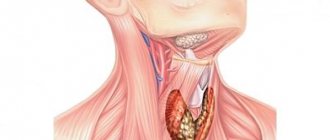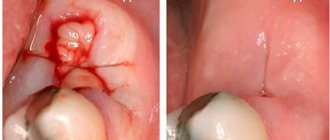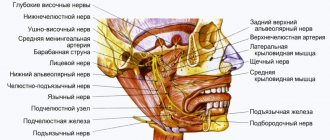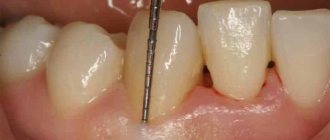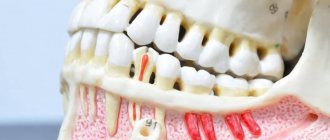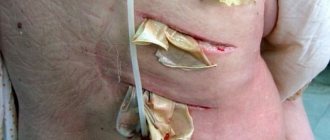Causes of pathology
If the lymph node in the neck under the jaw is inflamed, then the possible causes are:
- diseases of infectious origin that affect the ENT organs and the upper parts of the respiratory system (tonsillitis, sinusitis, tonsillitis, laryngitis, pharyngitis, otitis media);
- diseases developing in the oral cavity (caries, periodontal disease, periodontitis, periostitis, or gumboil, pulpitis, gingivitis, alveolitis, stomatitis);
- systemic infections (measles, whooping cough, mumps, popularly called mumps, chicken pox);
- pathologies affecting the immune system (lymphomas, leukemia, lupus, HIV);
- neoplasms (benign or malignant) of various origins (atheromas, granulomas, lipomas, cysts);
- infections caused by parasitic microflora (lymphoreticulosis, toxoplasmosis);
- disruptions in the functioning of the immune system.
You should know that the above ailments are not always accompanied by inflammation of the lymph nodes. Quite often, the nodes remain in a normal state even if the disease is acute.
If the lymph node under the jaw is inflamed, then in 60% of cases the pathology is caused by dental problems, in 30% by diseases of the respiratory system. In 20% of cases, the reason why the lymph node under the jaw is inflamed and hurts is advanced caries, leading to the development of a purulent abscess. After tooth extraction or conservative treatment of caries, pathological processes in the lymph nodes stop.
But sometimes it is tooth extraction that can become a provoking factor and cause an enlarged lymph node. A similar situation is possible if an infection enters the hole.
Types and symptoms of periostitis
Periostitis can be acute and chronic, aseptic and infectious. Depending on the nature of the disease, several types of disease are distinguished, each of which is accompanied by typical manifestations. The disease can affect any bones, but most often appears in the lower jaw.
Simple
Simple periostitis of the tooth is an aseptic inflammatory process that develops against the background of a bruise or fracture, as well as in connection with foci of inflammation near the periosteum, for example, in the muscles. The disease is accompanied by moderate swelling of the soft tissues. They rise above healthy areas and pain occurs when touched. Usually the simple form of the disease is well treatable - inflammation can be overcome already on the fifth or sixth day.
Fibrous
Fibrous periostitis is formed during a long-term inflammatory process, begins gradually, and proceeds in a chronic form. Exacerbations may occur from time to time. This form of the disease involves the formation of new tissue on the surface of the jaw.
Serous
The serous form of the disease is accompanied by the formation of an infiltrate - serous exudate appears at the site of inflammation. In the absence of treatment for acute periostitis of this type of inflammation, there is a possibility of the development of purulent processes characterized by a more severe course.
Purulent
Purulent periostitis can be a consequence of infection, for example, with injuries accompanied by damage to the periosteum, the spread of the inflammatory process from other foci (phlegmon). The causative agents of inflammation are often streptococci and staphylococci. The disease is severe, with pronounced symptoms and fever. As a result, fistula tracts are often formed, through which purulent contents are discharged out into the oral cavity. In this case, temporary relief occurs, but the disease does not go away completely.
Acute periostitis with a predominance of putrefactive processes is also distinguished. The periosteum swells, disintegrates, and the purulent contents go directly to the bone, spreading into the soft tissues, which leads to phlegmon of the jaw. This dangerous complication can cause severe consequences and even death.
Symptoms of periostitis depend on the form of the disease, general health, the presence or absence of chronic pathologies, age, etc. Typical signs include the following:
- redness of the mucous membranes of the gums, swelling;
- pain that increases with pressure, chewing, or drinking hot drinks;
- increased body temperature;
- facial asymmetry, cheek swelling;
- enlargement of the submandibular, behind-the-ear, sometimes cervical lymph nodes, etc.
It is worth noting that the purulent form of the disease proceeds faster and is accompanied by symptoms of general intoxication, higher temperature, and irradiation of pain to the temple and ear. Many people note a characteristic pulsation at the site of inflammation.
Stages of disease development and symptoms
Lymphadenitis in its development goes through 3 stages:
- stage
– the lymph nodes take on the appearance of mobile, compacted tubercles, when pressure is applied to them, pain appears, the temperature rises, sleep is disturbed, and general weakness is detected;
- stage (purulent abscess)
– the lymph node enlarges more and hurts even if you don’t touch it, which limits the motor activity of the jaw, pus accumulates in the lymph node, the skin around it becomes red, and the temperature is constantly elevated;
- stage (purulent phlegmon)
– the tumor spreads to the lymph nodes located in the armpits, the pain intensifies significantly, the skin turns blue, the temperature rises to 40⁰.
Why does my neck swell?
Traumatic injuries
Soft tissue bruises are accompanied by moderate local swelling and pain that intensifies during neck movements.
The swelling disappears within a few days. Subluxation of the cervical vertebra occurs as a result of a sharp turn of the head, and is more often detected in children. Asymmetrical swelling of the back of the neck is complemented by a forced position of the head, pain, and muscle tension. In case of fractures, local swelling is determined in the projection of the spinous process of the damaged vertebra. In victims with laryngeal injuries, external swelling is usually minor. Severe swelling can be a consequence of severe complications: internal bleeding into soft tissues, subcutaneous emphysema that occurs against the background of a rupture or penetrating wound of the larynx. Difficulty breathing, aphonia, and pain are noted. Hemoptysis and asphyxia are possible.
With uncomplicated laryngeal foreign bodies, there is no symptom. Against the background of inflammation in the area where a foreign object is located, swelling of varying severity occurs, combined with pain, hyperthermia, and symptoms of intoxication. A life-threatening condition is perforation of the larynx by a sharp foreign body with the development of subcutaneous emphysema.
Diseases of the lymphatic system
Swelling of the neck is often associated with inflammation of the regional lymph nodes. The following diseases can cause lymphadenitis:
- Purulent lesions of soft tissues
: infected wounds, boils, carbuncles, abscesses, phlegmon of the face, head and neck. - Dental problems
: caries, pulpitis, gumboil, stomatitis, purulent mumps, maxillary abscess, abscesses of the tongue, oral cavity, osteomyelitis of the jaw. - ENT pathologies
: tonsillitis, chronic tonsillitis, paratonsillar, parapharyngeal, intratonsilal abscesses, otitis, pharyngitis, laryngitis. - Children's infectious diseases
: diphtheria, scarlet fever, mumps. - Dangerous infections
: plague, anthrax.
In children with chronic skin diseases, lymphadenitis of the cervical, submandibular, and occipital lymph nodes occurs with the development of Kaposi's eczema herpetiformis. Enlarged lymph nodes also become a consequence of the lymphogenous spread of malignant tumors: cancer of the tongue, lower and upper jaw, larynx, pharynx, nose, paranasal sinuses.
Swelling of the neck due to thyroiditis
Endocrine pathologies
The most pronounced diffuse swelling of the neck is observed with myxedema. Not only the neck, but also the face swells; in severe cases, the swelling spreads throughout the body. Distinctive features are the absence of redness, pallor, pitting when pressing on the skin, shortness of breath, lethargy, lethargy, and increased sensitivity to cold. Changes in the anterior surface of the neck are determined in all forms of goiter:
- Diffuse euthyroid goiter.
The general condition has not changed, sometimes weakness and headaches are observed. In mild cases, swelling is noticeable only when palpating, tilting the head back, in severe cases it reaches the level of a pronounced cosmetic defect. - Diffuse toxic goiter.
Detailed symptoms of thyrotoxicosis are detected. The thyroid gland is uniformly enlarged, the degree of swelling does not always correlate with the severity of the disease. - Nodular goiter.
The function of the gland is often preserved; some patients show signs of hypo- or hyperthyroidism. The swelling of the neck is uneven, one side is larger than the other.
In acute thyroiditis, swelling is combined with pain, local hyperthermia, hyperthermia. The onset of the purulent form of thyroiditis is marked by increased pain, severe fever, and lymphadenitis. In patients with subacute thyroiditis, the body temperature is subfebrile, there is swelling, moderate pain in the projection of the thyroid gland, in half of the cases symptoms of thyrotoxicosis are detected. Chronic thyroiditis develops gradually. The affected area is lumpy and painless.
Maxillofacial pathology
The cause of swelling is often diseases of the salivary glands and soft tissues. Swelling is observed in the following pathological conditions:
- Sialadenitis.
The parotid salivary gland most often suffers; a one-sided painful swelling is located on the border of the neck and lower jaw, next to the earlobe. Less commonly affected are the submandibular salivary glands, which are localized in the submandibular triangle of the neck. - Purulent parotitis.
With purulent inflammation, swelling spreads to the neck, cheek, and submandibular area on the affected side. A pronounced deformation occurs. Pain, general hyperthermia, severe weakness, weakness are noted. - Salivary gland abscess.
Along with the parotid, other salivary glands may be affected. In 50% of cases, inflammation affects the paired organ. The area of swelling corresponds to the location of the affected gland. There is severe pain, febrile body temperature, and severe intoxication syndrome. - Perimaxillary abscess.
Formed as a complication of tonsillitis, furunculosis, infected abrasions of the skin and oral mucosa. Unilateral swelling is detected in the area of the submandibular triangle. When the abscess ruptures, swelling spreads down the neck. - Cellulitis of the neck.
It is provoked by odontogenic or tonsillogenic infection, foreign bodies of the laryngopharynx. Swelling appears on one side, grows quickly, and diffusely covers a significant part of the neck. The skin over the area of swelling is red, hot, and tense. The general condition is serious.
Diseases of the ENT organs
Swelling of the neck in otolaryngological diseases is often caused by lymphadenitis. Diseases accompanied by swelling of the neck, not associated with enlarged lymph nodes, include:
- Chondroperichondritis of the larynx.
A limited area of swelling is located in the front of the lower or middle third of the neck. Combined with chills, weakness, hyperthermia, pain, aggravated by talking, coughing, swallowing. - Neck cyst.
The tumor-like formation is localized on the lateral or anterior surface, and is more clearly contoured when the head is turned in the opposite direction. In the absence of inflammation, it is asymptomatic. When infected, the skin turns red, the cyst enlarges, becomes painful, and swelling spreads beyond the affected area. - Retropharyngeal abscess.
Swelling of the neck behind the angle of the lower jaw, sore throat, breathing problems aggravated in an upright position, severe impairment of the general condition, and hyperthermia are detected. - Lemierre's syndrome.
Postanginal anaerobic sepsis is manifested by swelling of the lower part of the lateral surface of the neck (in the projection of the jugular vein), pain, progressive deterioration of the condition up to impairment of consciousness and speech, the development of pneumonia, arthritis, and osteomyelitis. - Ludwig's sore throat.
The disease is characterized by a rapid onset and severe course with fever, intoxication, severe sore throat, and diffuse swelling of the soft tissues of the neck. On palpation, the tissues are painful, dense, and “woody.”
Allergy
With angioedema, swelling of the neck, face, lips, eyelids, ears, limbs, and genital area is observed. The swelling is painless, accompanied by a feeling of tension and fullness, and pale skin. It is provoked by contact with allergens: drugs, food, insect poison. Sometimes it occurs due to pseudo-allergy. In addition, severe swelling of the face, neck, feet, and hands is found in the edematous type of allergy to salicylates.
Infectious diseases
The most common infectious cause of neck swelling is mumps. Swelling is detected in the area of the salivary glands, often bilateral, sometimes asymmetrical. Due to the enlargement of the upper parts of the neck, the face becomes pear-shaped. Severe swelling of the anterior parts of the neck is detected in the toxic form of diphtheria. 1st degree is characterized by swelling reaching the middle of the neck, 2nd – to the collarbones, 3rd – spreading to the face, chest, back, back of the neck.
In patients with typhus, redness and swelling of the face and neck are accompanied by injection of the conjunctiva, the appearance of a thick rash on the torso and limbs, hepatosplenomegaly, oliguria, neurological disorders, and severe intoxication.
Neoplasms
Local swelling of the neck may be due to the development of neoplasia, which includes:
- lipomas, fibromas;
- cancer of the pharynx and larynx;
- thyroid tumors.
Benign neoplasms are limited, painless swellings that do not increase or increase very slowly in size. Malignant neoplasia rapidly progresses, causes enlargement of lymph nodes, invades neighboring organs, and is accompanied by breathing and swallowing disorders, and voice changes.
Other reasons
The list of other causes of neck swelling includes a number of diseases of various etiologies:
- Rheumatology, orthopedics
: cervical myositis, Shulman's disease, scleroderma, dermatomyositis. - Cardiology, pulmonology
: exudative pericarditis, pleurisy, mediastinitis, superior vena cava syndrome. - Dermatology
: furunculosis, bullous dermatitis. - Neurology
: Melkersson-Rosenthal syndrome. - Nephrology
: membranous glomerulonephritis. - Emergency conditions
: cytokine storm.
Treatment methods
If the lymph node under the jaw is inflamed, how to treat it? The choice of treatment method is influenced by the cause of the pathology and its neglect. In mild cases, if the cause is eliminated, the inflammation will stop and the lymph node will return to its previous size. If complications are detected, the doctor will prescribe antibiotics or antiviral medications, painkillers, antipyretics and antihistamines. It is also necessary to take vitamins to strengthen the body's defenses. Traditional medicine will help speed up the healing process and eliminate unpleasant symptoms. The course of therapy takes a week and a half.
If a purulent infection occurs, then there will be a need for surgical intervention, during which the surgeon will open the inflamed lymph node and pump out the pus. Fortunately, this situation is extremely rare.
This article is for informational purposes only, please consult your doctor for details!
Treatment
Pre-hospital assistance
In case of traumatic injuries, the neck must be secured with a cotton-gauze collar. In other cases, it is recommended to provide functional rest to the neck and not self-medicate, since swelling occurs in many diseases that require different approaches to therapy. In case of intense pain, the use of painkillers is allowed. You should not warm your neck - this can intensify inflammatory and other pathological processes.
Conservative therapy
The conservative treatment regimen includes a protective regimen, etiopathogenetic and symptomatic drug therapy, and physical therapy. The following medications are used:
- NSAIDs
. They are used in the form of tablets, injections, and local remedies. They have analgesic and anti-inflammatory effects. - Antibiotics
. Broad-spectrum medications are prescribed, and after culture results are obtained, medications are replaced taking into account the sensitivity of the pathogen. For extensive purulent processes, combinations of two drugs are recommended. - Antithyroid drugs
. Hyperthyroidism is considered as an indication for the use of medications. For hypothyroidism, replacement therapy is carried out. - Antihistamines
. Necessary for neck swelling caused by allergic reactions.
After eliminating acute phenomena, UHF, laser therapy, electrophoresis with novocaine, and anti-inflammatory drugs are used. Patients with cancer undergo chemotherapy and radiation therapy.
Surgery
For acute pain, blockades with local anesthetics are performed. Taking into account the nature of the pathology, the following operations are performed:
- Traumatic injuries
: transoral fixation, application of a Halo-apparatus, PSO of neck wounds, tracheostomy, chordectomy, resection of the larynx, laryngopexy, removal of foreign bodies of the larynx, reconstructive interventions. - Maxillofacial pathologies
: parotidectomy, opening of abscesses and phlegmons of the neck, dilation of the excretory duct of the salivary gland. - Endocrine diseases
: enucleation of the node, subtotal resection of the thyroid gland, hemithyroidectomy. - Otolaryngological diseases
: removal of a median or lateral neck cyst, opening of a retropharyngeal abscess. - Tumors
: excision of lipomas and fibromas of the neck, removal of the thyroid gland, radioiodine therapy for thyroid cancer, laryngectomy, laryngopharyngectomy, hemilaryngectomy, installation of a voice prosthesis, Krail, Vanach operations.
Causes
How the tumor develops depends on the cause of its appearance.
There are several reasons for the development of tumors
The most common reasons are listed below.
- Injuries, blows, bruises of the cervical vertebrae and/or muscles. Such incidents can cause swelling and lead to breathing problems.
- Neck cyst. This problem most often occurs in children. If you do not get rid of it in time, purulent inflammation may develop, and subsequently a tumor.
- Inflammation of the lymph nodes. It is common in children and adults. An experienced doctor can easily determine it by palpation.
- Problems with the thyroid gland. In this case, the tumor most often develops in the front of the neck.
Prices for massagers

